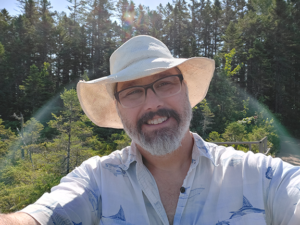Peter Avis
Assistant Professor in Ecosystem Genetics
Degree: Ph. D. 2003. University of Minnesota
Website: Avis Lab and Research
Phone: 581-2559
Email: peter.avis@maine.edu
Research Topic: Fungal biology, ecology, biogeography and evolution; molecular ecology, biomonitoring
Avis Research Overview
Fungi are vital, diverse yet vulnerable organisms. They are recognized as key life forms responsible for globally important ecological processes such as decomposition, nutrient cycling and disease. However, the millions species of fungi that exist today are increasingly confronted by global change via anthropogenic perturbations such as air pollution. My research utilizes the tools of mycology, molecular ecology and biomonitoring to address questions in three general categories: 1) Fungal ecology, phylogeny and biogeography; 2) Molecular methodology for the study of fungi (and other eukaryotes); and 3) Ecological restoration. Recently started projects and in collaboration with those at University of Maine that leverage the tools and expertise of Maine e-DNA (https://umaine.edu/edna/) include understanding the ecology of chytrids (and other zoosporic fungi) along freshwater to marine gradients, testing island biogeography predictions for ectomycorrhizal fungi using the islands of Maine, and characterizing the fungal communities associated with coarse woody debris decomposition and blueberry roots.
Publications
Adamcik S. et al (Avis P.G., Barajas M.*undergraduate two of 24 co-authors). 2019. The Quest for a Globally Comprehensible Russula Language. Fungal Diversity 99(1):369-449
Huysken K, Olivey H, McElmurry K, Gao M, & Avis P. 2019. Assessing Collaborative, Project-based Learning Models in Introductory Science Courses. Journal of the Scholarship of Teaching and Learning, 19(1). https://doi.org/10.14434/josotl.v19i1.26777
Avis, P.G., Meier, I. and Phillips, R. 2017. An Intact Soil Core Bioassay for Cultivating Forest Ectomycorrhizal Fungal Communities. In M. Lukac, P. Grenni & M. Gamboni (eds.), pp. 173-190. Soil biological communities and ecosystem resilience, Springer.
Avis P.G., Gaswick WC, Tonkovich GS, Leacock PR. 2017. Monitoring fungi in ecological restorations of coastal Indiana, USA. Restoration Ecology. 25(1):92-100.
Melera S, Ostellari C, Roemer N, Avis PG, Tonolla M, Barja F, Narduzzi-Wicht, B. 2017. Analysis of morphological, ecological and molecular characters of Russula pectinatoides
Peck and Russula praetervisa Sarnari, with a description of the new taxon Russula recondita Melera & Ostellari. Mycological Progress. 16(2):117-134.
Argyilan EP, Avis PG, Krekeler MPS, Morris CC. 2015. The origin of collapse features appearing in a migrating parabolic dune along the southern coast of Lake Michigan. Aeolian Research. 19:137-149.
Keirle M.R., Avis P.G., hemmes D.E. Mueller G.M. 2014. Testing the “one-log-one-genet” hypothesis: methodological challenges of population sampling for the Hawaiian wood-decay fungus Rhodocollybia laulaha. Mycologia. 106(5):896-903.
Meier I, Avis P.G., Phillips P. 2013. Fungal communities influence root exudation rates in tree seedlings. FEMS Microbiology Ecology. 83(3):585-95.
Norris M, Avis PG, Hobbie S, Reich P. 2013. Positive feedbacks between decomposition and Soil nitrogen availability along soil N gradients. Plant and Soil. 367(1-2):347 – 361.
Keirle M, Avis PG, Mueller G. 2012. Limited Divergence in the Spatially Subdivided Population of the Hawaiian Mushroom Rhodocollybia laulaha. Botany, 2012, 90(11): 1103-1112
Avis P.G., 2012. Ectomycorrhizal Iconoclasts: The ITS rDNA diversity and nitrophilic tendencies of foetid Russula. Mycologia. 104(5):998-1007
Keirle M.R., Avis P.G., Mueller G., Hemmes D. 2011. Investigating the Allelic Evolution of an Imperfect Microsatellite Locus in the Hawaiian Mushroom Rhodocollybia laulaha. Journal of Heredity 102(6):727-734.
Keirle M.R., Avis P.G., Mueller G., Hemmes D. 2011. Variability in the IGS1 region of Rhodocollybia laulaha: is it allelic, genomic, or artificial? Fungal Biology 115(3):310-316.
Keirle, M.R., Avis, P.G., Desjardin, D.E.,Hemmes, D.E., Mueller, G.M. 2010. Geographic origins and phylogenetic affinities of the only putative Hawaiian endemic Rhodocollybia. Mycotaxon 112:463-473.
Parrent J., Peay K., Arnold A.E., Comas L., Avis P.G., Tuininga A. 2010. Moving from pattern to process in fungal symbioses: linking functional traits, community ecology and phylogenetics. New Phytologist 185: 882-886.
Avis P.G., Branco S., Tang Y.*, Mueller, G. 2010. Pooled samples bias fungal community descriptions. Molecular Ecology Resources 10:135-141.
Dickie I.A., Dentinger B.T.M., Avis P.G., McLaughlin D.J., Reich P.B. 2009. Ectomycorrhizal fungal communities of oak savanna are distinct from forest communities. Mycologia 101(4):473-483.
Avis P.G., G.M. Mueller and J. Lussenhop. 2008. Ectomycorrhizal fungal communities in two North American oak forests respond to nitrogen addition. New Phytologist 179:472-483.
Avis P.G., Foster S. and Olexia P.D. 2008 Arbuscular mycorrhizal fungal root colonization and inoculum propagules in deciduous floodplain forests of southwestern Michigan, USA. The Michigan Botanist 46:121-128.
Avis P.G., I.A. Dickie, and G.M. Mueller. 2006. A “dirty” business: Testing the limitations of terminal restriction fragment length polymorphism (TRFLP) analysis of soil fungi. Molecular Ecology 15:873-882.
Avis P.G. and Feldheim K. A. 2005. A method to size DNA fragments from 50 to 800 base pairs on a DNA analyzer. Molecular Ecology Notes 5:969–970
Avis P.G. and I. D. Charvat. 2005. The response of ectomycorrhizal fungal inoculum to long-term increases in nitrogen supply. Mycologia 97(2): 329-337.
Avis, P.G., McLaughlin D.J., Dentinger B.C., and Reich P.B. 2003. Long-term increase in nitrogen supply alters above and below ground ectomycorrhizal communities and increases the dominance of Russula spp. in a temperate oak savanna. New Phytologist 160: 239-253.
Dickie I.D., Avis P.G., Reich P.B, and McLaughlin D.J. 2003. GERM: Good Enough RFLP Matching Program. Mycorrhiza 13:171-172.
Corbin J.C., Avis P.G., and Wilbur R. 2003. Effect of phosphorus addition on nitrogen cycling and arbuscular mycorrhizal inoculum potential in a nitrogen limited forest ecosystem. Environmental Air, Water and Soil Pollution 147:141-161.
Charvat, I., Avis P.G., Eichstaedt K., and Lin H.-W. 2004. Production and characterization of mycorrhizal fungal inoculum. MNDOT Final Report 2004.
Avis, P.G. 1997. The forest typology of Latvia: An overview and comparison. Proceedings of the Latvian Academy of Sciences. Sec. B, Vol. 51, No. 4:137-141.
